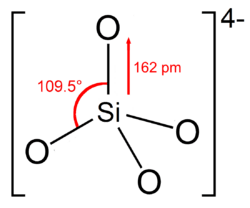Silicate facts for kids
In chemistry, a silicate is a special kind of chemical compound. It has one or more silicon atoms in the middle. These silicon atoms are surrounded by other atoms called ligands. These ligands like to pull electrons towards themselves.
Most silicates you'll find are made of silicon and oxygen. The oxygen atoms act as the ligands. Silicates often have a negative electrical charge. To become a balanced, neutral compound, they need positively charged atoms called cations to join them.
Silicates in Rocks and Earth
In geology, which is the study of Earth, the word silicate is used for types of rock. These rocks are mostly made of silicate minerals. Silicate minerals are the most common minerals on Earth. They make up about 90% of Earth's crust!
How Silicate Rocks Form
Earth's crust has many different silicate minerals. They mix in countless ways. This happens because of natural processes that form and change the crust. Some of these processes include:
- Melting: When rocks get very hot deep inside Earth, they can partly melt.
- Crystallization: As melted rock cools, minerals form crystals.
- Metamorphism: Old rocks change into new ones due to heat and pressure.
- Weathering: Rocks on the surface break down into smaller pieces.
- Diagenesis: These small pieces then turn into new rocks over time.
Silicates and Living Things
Living things also play a part in the silicate cycle near Earth's surface. For example, tiny ocean creatures called diatoms use silica. Silica is a common silicate. Diatoms build their hard outer shells, called tests, from silica.
When diatoms die, their shells sink to the bottom of the deep ocean. These tiny shells become a major part of the sediment there. Over millions of years, this sediment can turn into rock.
See also
 In Spanish: Silicato para niños
In Spanish: Silicato para niños


